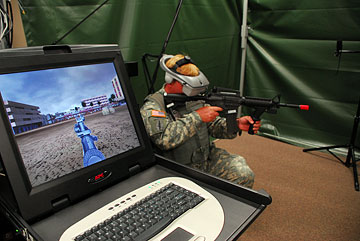 GREGG K. KAKESAKO / GKAKESAKO@STARBULLETIN.COM
With the help of computers that create virtual-reality simulations, soldiers can practice infantry techniques in a training area at Schofield Barracks. In training yesterday, Master Sgt. Jim Guzion aimed his rifle at a simulated Baghdad street. CLICK FOR LARGE |
|
Reality Strykes when soldiers drive simulator
Peter Heinrich drives to work in a compact car that weighs less than 2 tons.
At work, the "muscle car" he drives is a nearly 19-ton, eight-wheeled Stryker combat vehicle.
But Heinrich, an Army private first class, said the Stryker handles much like his Ford Escort.
Ten members of his platoon from Alpha Company, 1st Battalion, 21st Infantry Regiment, tested their driving skills yesterday on a $900,000 simulator.
It is just one of the virtual-reality training devices the Army is using to prepare nearly 4,000 Schofield Barracks soldiers from the 2nd Stryker Brigade Combat Team for a year-long tour in Iraq.
"Live-fire training is the most important training that we do," said Lt. Col. Mike Staver, Schofield Barracks battle simulation officer. "Simulation training helps us prepare for that."
Clayton Creech, who demonstrated the Army's virtual squad training system to reporters yesterday, said, "Simulation training cannot replicate live training. It can only augment live training."
His $1.3 million simulators, which include a hood and specially adapted rifles, are to help individual soldiers get accustomed to various situations -- ambushes, homemade bombs, medical evacuations, and entering and clearing buildings -- that they will encounter in Iraq.
In another section of the Battle Command Training Center at Schofield Barracks, simulators are used to educate soldiers on how to conduct four-vehicle convoys. After each session, drivers and their two gunners review their "convoy missions" and how they reacted.
The newest simulator, installed less than a month ago, is used to train the several hundred soldiers who will drive Strykers. So far, the 2nd Brigade has received 311 Strykers, with the last 28, armed with 105-mm cannons, expected to arrive here next month, well in advance of the Iraq deployment in December.
The drivers are strapped into a cockpit, complete with steering wheel, brake and gas pedal, that sits on hydraulics that can replicate vehicle motions, including a rollover. Three life-size monitors face the driver and his only contact with the outside world is through his helmet, which is wired to an instructor's console.
At yesterday's session, David Polk, computer operator and instructor, presented a range of situations for the drivers from Alpha Company.
Polk had three small monitors in front of him that gave him a view of the training scenarios that were being used, the situation confronting the driver, and a view of the cockpit and the Stryker driver in it.
Heinrich, 29, said he had actually driven a Stryker at least 20 times before using the simulation trainer.
"Lot of it is the same," Heinrich said after his first session. "The actual Stryker moves like the simulator. You can forget that you are in a trainer.
"If it wasn't for the screen (monitors), you would think you were actually driving the real thing."
Staver said that simulation training provides opportunities when the Army cannot do live training "because it is dangerous or expensive" or because of environmental constraints, time or resources.
He said one of the benefits of simulation training, such as the Stryker driver system, is that "you can crash a vehicle time and time again and then reset it."

